In addition to the traditional Y-chromosome DNA testing performed by FamilyTreeDNA, several members of the Pike DNA Project and/or their close relatives have done genome-wide DNA tests at 23andMe. This is the same DNA test that TIME Magazine rated as the best invention of the year 2008.
This webpage attempts to convey some of the insights and lessons that we have learned from these types of tests.
Background and Introduction
The genome-wide DNA scans that are performed by 23andMe involve testing just over 500,000 genetic markers (called SNPs) that are distributed throughout a person's DNA. Note, however, that the human genome consists of over 3 billion SNPs, so 23andMe is not performing a "complete" DNA scan. Nevertheless, the half million SNPs that are tested do provide a large amount of information that can be used for ancestral and genealogical purposes.
In terms of genealogy, when a collection of SNPs that are close to each other in the genome are identical in two people, it is likely that the corresponding chunks or segments of DNA were inherited by both of them from a common ancestor. So if two people share a DNA segment then they are related in some way. If they only share one DNA segment, then their common ancestor is likely to have been 5 or more generations in the past. However, if two people share 2, 3, or more segments, then it becomes more likely that their common ancestor is more recent.
23andMe has a utility called "Relative Finder" that enables people who share DNA segments with each other to contact each other. Often these people are strangers at first, even though they are related in some (possibly distant) way. By comparing pedigrees with each other, they can sometimes determine who their common ancestors are, and in so doing they can also determine the path of inheritance that their shared DNA segment(s) took through their family tree.
Unlike the traditional Y-DNA tests that are performed by FamilyTreeDNA, anybody, whether male or female, can do a genome-wide test at 23andMe.
Note, however, that a genome-wide test done at 23andMe is not a substitute for the traditional Y-DNA or mtDNA testing done by FamilyTreeDNA. We recommend that, whenever possible, you begin the process of investigating your Pike family's genetic past by having the Y-chromosome of a male Pike in your family (be it yourself or a relative of yours) tested at FamilyTreeDNA. The genome-wide tests offered by 23andMe are probably better suited as a secondary tool for more advanced genealogical research, or for cases where there is no alternative (as may be the case for women who cannot find any suitable male relatives to provide a Pike Y-chromosome for analysis).
Some Lessons that We've Learned
- If two people are fourth cousins or closer then they are almost certain to share at least one DNA segment with each other.
First cousins (and closer relatives) have a large number of DNA segments in common with each other.
- It is unlikely that two people who are more distantly related than fifth cousins will share any DNA segments.
Said another way, the probability that they share a segment falls below 50%.
However, given the sheer number of fifth, sixth, etc., cousins that we each have, even if only 10% of them share
a DNA segment with you then you will find that a large number of distant relatives are detected by 23andMe.
Remember though that these detected distant cousins are a minority of the distant cousins that you actually have
(the majority of them just don't share any DNA segments with you).
- If two people share a DNA segment with each other, then assuming which of their parents, grandparents, etc., carried these segments
can be error-prone if no additional information is taken into consideration.
It is advisable to rely on matches with additional people who also share the same DNA segments,
and then consult the pedigrees of these other people, in order to confirm what the most likely ancestral sources are for
the DNA segments in question. This is especially important when somebody's parents, grandparents, etc.,
come from the same geographical area (and hence might have some overlap in their gene pool).
- The part of the 23andMe tests that pertains to the male Y-chromosome focusses on SNPs that are likely to have
remained unchanged for thousands of years. This means that many men, with many different surnames, will have the
same results for their Y-chromosome SNPs. Hence the Y-chromosome results reported by 23andMe cannot be
used to verify that two Pike men belong to the same Pike family. This verification would have to be done by the
type of DNA test that FamilyTreeDNA performs on the Y-chromosome (e.g., with a 37-marker test that consists of
STRs (short tandem repeats) rather than SNPs).
- Identifying relatives via 23andMe is facilitated via their new "Relative Finder" tool. However, identifying common ancestors is a task that requires that both you and they have researched the many branches of their ancestry for several generations. For instance, you and a fourth cousin would share a pair of great great great grandparents, but the number of great great great grandparents that each person has is 32. If you or your cousins don't know who these ancestors are, then figuring out your connection could be difficult.
- Autosomal Inheritance Tutorial
- ISOGG Page: I've Tested at 23andMe, Now What?
- Health and Traits at 23andMe
- Ancestral Origins at 23andMe
A Case Study in Known Relationships
Here we present some comparative results for four people (Angus, Dave, David, and Wayne) who are related to each other as follows:
- David is Angus' son
- Wayne is Angus' nephew
- Dave is Angus' fourth cousin
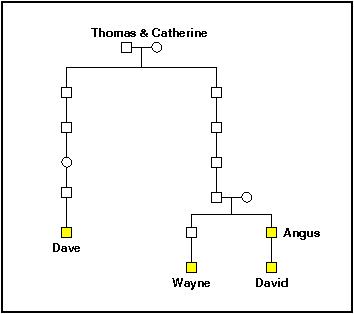
Father and Son:
Regarding the DNA that David inherited from his father Angus, this is shown in the illustration below.
To elaborate, David has 22 pairs of autosomal chromosomes, numbered 1 to 22. For each pair, David inherited one
of the chromosomes from his father Angus, which is confirmed by the light blue shading shown for chromosomes 1 to 22 in the diagram.
Men do not pass on their X chromosome to their sons, so it is unlikely that David and Angus would have shared any DNA segments
between their X chromomes; the white shading below confirms that there are no shared DNA segments on the X chromosome.
David's entire Y-chromosome came from his father, but the type of testing done by 23andMe consists of SNPs (not the STR markers
that FamilyTreeDNA tests). At least in part because the Y chromosome is not subject to recombination, the SNP tests done
by 23andMe on the Y chromosome can yield the same results in men who are not closely related (although they are related in an
anthropological time frame) and so 23andMe always colours the Y chromosome gray. Note that there are also regions of
chromosomes (such as 1, 9, 13, 14, 15, 21, 22) that are not considered by 23andMe and these too are shaded in gray.
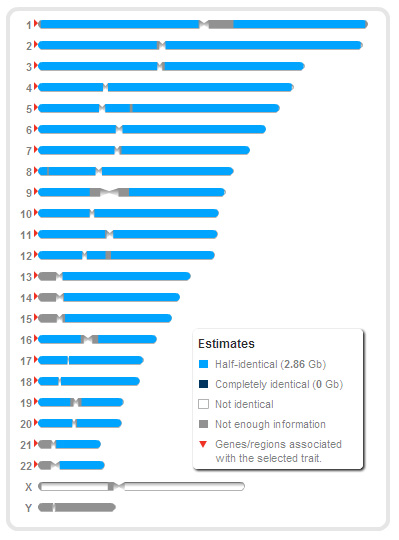 Angus and David
Angus and David
|
Uncle and Nephew:
As can be seen in the diagram below, Angus and Wayne share a large amount of DNA. If you count them up, they have 41 distinct
DNA segments in common. Some of these segments are short (such as the small one near the start of chromosome 4) while others
are quite long (such as the lengthy segment that spans the centromere of chromosome 3).
On chromosome 20, Angus and Wayne match on the entire chromosome. Since chromosomes 1-22 come in pairs, this means that one of Angus' two chromosome #20s is the same as one of Wayne's. In turn this likely means that this chromosome did not undergo any recombination when Wayne, his father, or his uncle Angus were conceived. What we cannot tell from the available information though is which of Angus' two parents carried the DNA that is now shared by Angus and Wayne. To figure that out will require finding other people who also share some portion of this DNA segment and then looking at their pedigree to see if they have common ancestry with Angus' father or with Angus' mother.
On chromosome 17, Angus and Wayne have nearly no shared DNA. So along the white-shared area, the DNA segments along Wayne's two chromosome #17s is different than the corresponding segments along Angus' two chromosome #17s.
On chromosome 20, Angus and Wayne have a DNA segment that has been coloured dark blue by 23andMe. This indicates that both of Angus' two chromosomes match with both of Wayne's along this part of chromosome 20. Since one of Wayne's chromosome #20s was passed on to him by his mother, this indicates that Wayne's mother would have shared a DNA segment with Angus, meaning that Angus was related in some way to Wayne's mother. This we knew already: Angus is a second cousin of Wayne's mother.
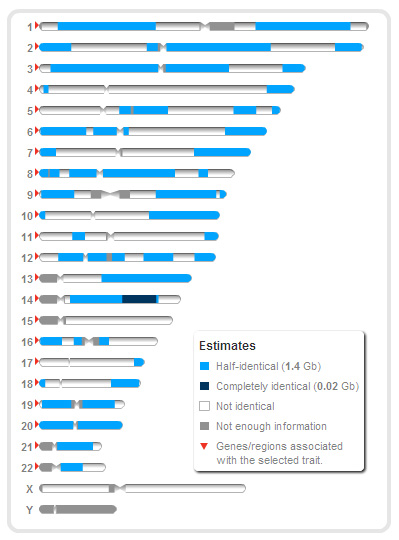 Angus and Wayne
Angus and Wayne
|
First Cousins:
David and Wayne's results are compared in the diagram below.
In total they share 23 DNA segments. If you look at the diagram above (for Angus and Wayne) and
compare it to the one below (for David and Wayne) you can see that the DNA shared by David and Wayne is
also shared by Angus and Wayne. But not all of the DNA shared by Angus and Wayne is shared by David and Wayne.
Only half of Angus' DNA on chromosomes 1-22 was passed on to his son David, and so whenever the half that got
passed on was not the half shared with Wayne then David would end up not having DNA in common with Wayne for that part of their DNA.
For example, Angus and Wayne share a large portion of DNA on chromosome 20, but David and Wayne share none. So, of
Angus' two chromosome #20s, David must have inherited the one that was different from Wayne's chromosome #20s.
That David only inherited half of his father's DNA explains why the total amount of DNA that Wayne and David share with each other (i.e., the part coloured in light blue) is roughly half of the total amount of DNA that Wayne and Angus shared with each other (i.e., the parts coloured light or dark blue above). Indeed, by using 23andMe's "Relative Finder" tool, Wayne and Angus are reported as having 24.58% of their DNA in common with each other, whereas Wayne and David are reported as having 12.16% of their DNA in common with each other (these numbers are consistent with the expected values of roughly 25% and 12.5% for the respective relationships).
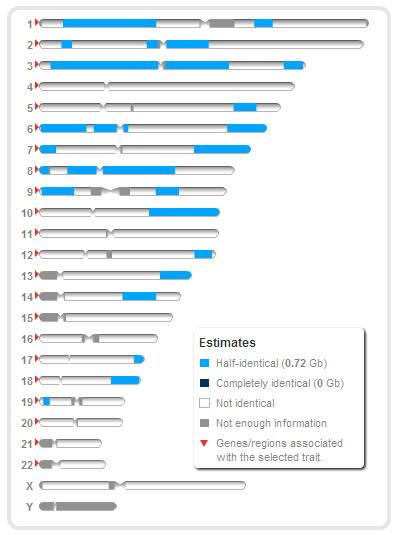 David and Wayne
David and Wayne
|
Fourth Cousins:
Angus and Dave are fourth cousins, with their most recent common ancestors being Thomas & Catherine Pike.
Since a parent only passes half of his/her DNA on to a child, then roughly one sixteenth of Angus' DNA would be expected
to come from Thomas & Catherine. Likewise one sixteenth (or 6.25%) of Dave's DNA would be expected to come from Thomas & Catherine.
Angus and Dave, being fourth cousins, should have about one 512th of their DNA in common with each other.
However, the inheritance of DNA segments is often an all-or-nothing situation, so the real question is whether any shared segments can be found. In the case of Angus and Dave, yes, they share two short segments, on chromsomes 5 and 9. The "Relative Finder" tool reports that these segments amount to 0.28% of their total DNA. Note that one 512th would be about 0.20%, so the amount of DNA that Angus and Dave share is consistent with the knowledge that they are fourth cousins.
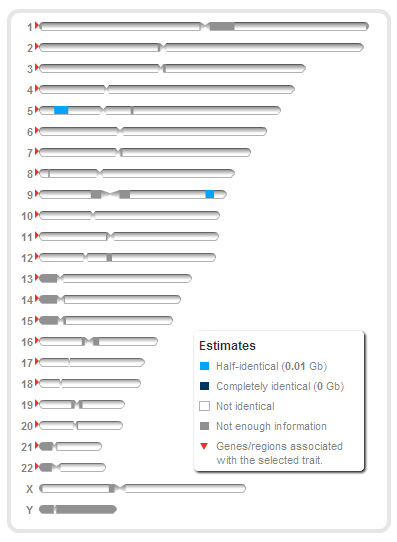 Angus and Dave
Angus and Dave
|
Fourth Cousins, Once Removed:
Dave and David share the same DNA segment on chromosome 5 that is shared by Dave and Angus.
But the segment on chromosome 9 that Dave and Angus share is not shared by David and Dave, so clearly Angus
did not pass this segment on to his son David.
However, Dave and David also share another tiny segment on chromosome 22. Since Dave and Angus do not share this piece of DNA, then this suggests that Dave shares this segment with David's mother. This has since been confirmed by doing a DNA test on David's mother. However, it remains unknown how David's mother and Dave might have both inherited the same DNA segment (i.e., the relationship that this is suggesting exists between them has not yet been determined).
Had David's parents not been tested, then we might have mistakenly assumed that the DNA segment that is shared on chromosome 22 by David and Dave was a piece of DNA that traced back to Thomas & Catherine Pike.
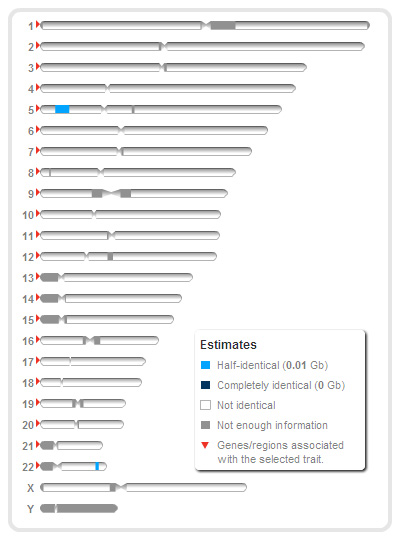 David and Dave
David and Dave
|
A Case Study in Unknown Relationships
Within our project's "Group 2" are several Pikes with ancestry from Carbonear, Newfoundland, many of whom cannot establish a relationship based on historical records. But DNA testing at FamilyTreeDNA has revealed that they share similar Y chromosomes and therefore their direct all-male Pike ancestral lines go back to a common Pike ancestor. Two such members of our "Group 2" are David and Philip. At 23andMe it was discovered that they share a moderate-sized DNA segment on chromosome 2 as shown below:
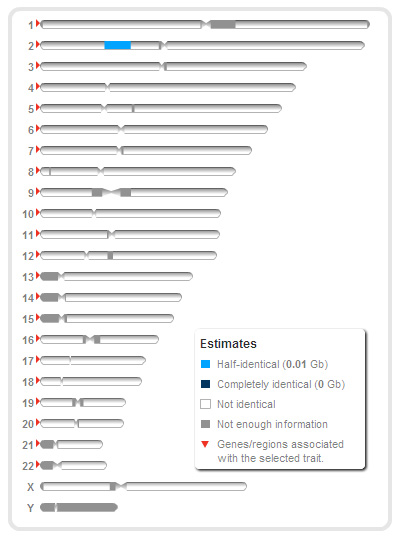 David and Philip
David and Philip
|
Given that we know that there must be a connection between David's Pike ancestral line and Philip's Pike ancestral line, we at first believed that this DNA segment had been inherited from David and Philip's as yet unidentified common Pike ancestors.
But we were wrong. After David's parents were also tested at 23andMe it was discovered that Philip shares no DNA segments with David's father Angus. On the other hand, Philip and David's mother Bessie share four DNA segments, on chromosomes 2, 15, 20 and X, as illustrated below:
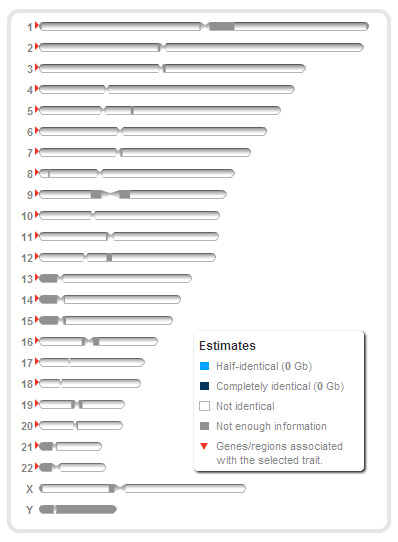 Angus and Philip
Angus and Philip
|
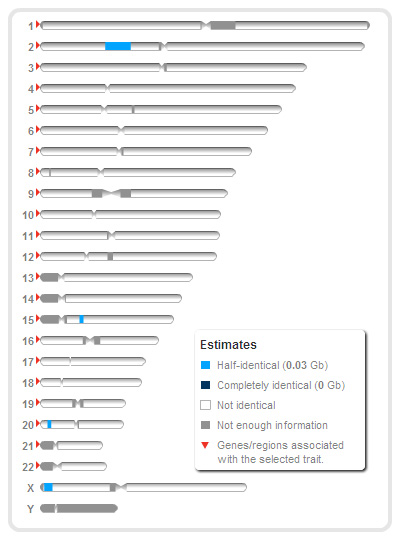 Bessie and Philip
Bessie and Philip
|
As it turns out, David's mother and Philip's mother are related. David and Philip did not previously know that this was so, but now that they have been looking for the source of these DNA segments it has been discovered that David's mother and Philip's mother both have Sheppard ancestors from the small community of Harbour Grace South in Newfoundland.
Last Modified: Wednesday, 28 March 2018, 17:15:21 NDT